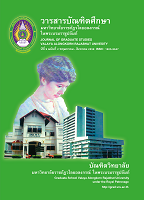การพัฒนารูปแบบการจัดการเรียนรู้ที่พัฒนากระบวนการสำคัญทางคณิตศาสตร์สำหรับนักเรียนระดับประถมศึกษา THE DEVELOPMENT OF A LEARNING MANAGEMENT MODEL TO DEVELOP THE ESSENTIAL MATHEMATICAL PROCESS FOR ELEMENTARY SCHOOL STUDENTS
Main Article Content
Abstract
บทคัดย่อ
การวิจัยครั้งนี้มีวัตถุประสงค์เพื่อศึกษาและวิเคราะห์องค์ประกอบของกระบวนการสำคัญทางคณิตศาสตร์ สำหรับนักเรียนระดับประถมศึกษา เพื่อนำเสนอรูปแบบการจัดการเรียนรู้ที่พัฒนากระบวนการสำคัญทางคณิตศาสตร์สำหรับนักเรียนระดับประถมศึกษา และเพื่อศึกษาผลการใช้รูปแบบการจัดการเรียนรู้ที่พัฒนากระบวนการสำคัญทางคณิตศาสตร์สำหรับนักเรียนระดับประถมศึกษา การดำเนินการวิจัยแบ่งเป็น 3 ระยะ คือ ระยะที่ 1 เป็นการศึกษาและวิเคราะห์องค์ประกอบของกระบวนการสำคัญทางคณิตศาสตร์สำหรับนักเรียนระดับประถมศึกษา โดยใช้การวิเคราะห์องค์ประกอบ (Factor Analysis) ระยะที่ 2 เป็นการเสนอรูปแบบการจัดการเรียนรู้ที่พัฒนากระบวนการสำคัญทางคณิตศาสตร์สำหรับนักเรียนระดับประถมศึกษา และระยะที่ 3 เป็นการศึกษาผลการใช้รูปแบบการจัดการเรียนรู้ที่พัฒนากระบวนการสำคัญทางคณิตศาสตร์สำหรับนักเรียนระดับประถมศึกษา กลุ่มตัวอย่างที่ใช้ในการทดลองสอนคือ นักเรียนชั้นประถมศึกษาปีที่ 6 ในโรงเรียนวัดถนน สังกัดสำนักงานเขตพื้นที่การศึกษาประถมศึกษาอ่างทอง ปีการศึกษา 2555 จำนวน 26 คน เครื่องมือที่ใช้ในการวิจัยประกอบด้วย แผนการจัดการเรียนรู้จำนวน 10 แผน ในแต่ละแผนมีขั้นตอนการจัดกระบวนการเรียนรู้ดังนี้ ขั้นที่ 1 ขั้นนำเสนอสถานการณ์ ขั้นที่ 2 ขั้นสร้างความเชื่อมโยงสู่สถานการณ์ ขั้นที่ 3 ขั้นทำความเข้าใจสถานการณ์ ขั้นที่ 4 ขั้นอภิปรายและวางแผนแก้ปัญหา ขั้นที่ 5 ขั้นตัดสินใจแก้ปัญหาและให้เหตุผล ขั้นที่ 6 ขั้นตรวจสอบ ขั้นที่ 7 ขั้นฝึกทักษะ ขั้นที่ 8 ขั้นสรุป และขั้นที่ 9 ขั้นประเมินผลและนำไปใช้ แบบทดสอบวัดกระบวนการทางคณิตศาสตร์ จำนวน 6 ชุด แต่ละชุดวัดกระบวนการแก้ปัญหาและการให้เหตุผลในด้านการทำความเข้าใจปัญหา การวางแผน การแก้ปัญหา การดำเนินการตามแผน การตรวจสอบ การจำแนก การเปรียบเทียบ การเชื่อมโยงความสัมพันธ์และการนำไปใช้ และการวิเคราะห์ ผู้วิจัยทดลองสอนเป็นเวลา 10 สัปดาห์ สัปดาห์ละ 3 ชั่วโมง รวมทั้งสิ้น 30 ชั่วโมง การทดสอบวัดกระบวนการทางคณิตศาสตร์ทดสอบก่อนเรียนและทดสอบหลังเรียนทุก 2 สัปดาห์ รวมจำนวน 6 ครั้ง สถิติที่ใช้ใน การวิเคราะห์ความแปรปรวนแบบวัดซ้ำ (Repeated Measure ANOVA)
ผลการวิจัยพบว่า
1. กระบวนการสำคัญทางคณิตศาสตร์สำหรับนักเรียนระดับประถมศึกษา ได้แก่ กระบวนการแก้ปัญหาและกระบวนการให้เหตุผล และองค์ประกอบของกระบวนการแก้ปัญหาที่สำคัญแบ่งเป็น 4 ด้าน คือ 1) การทำความเข้าใจปัญหา 2) การวางแผนการแก้ปัญหา 3) การดำเนินการตามแผน 4) การตรวจสอบ องค์ประกอบของกระบวนการให้เหตุผลที่สำคัญแบ่งได้เป็น 4 ด้าน 1) การจำแนก 2) การเปรียบเทียบ 3) การเชื่อมโยงความสัมพันธ์และการนำไปใช้ และ 4) การวิเคราะห์
2. รูปแบบการจัดการเรียนรู้ที่พัฒนากระบวนการสำคัญทางคณิตศาสตร์สำหรับนักเรียนระดับประถมศึกษา ประกอบด้วย (1) ทฤษฎี หลักการ แนวคิดของรูปแบบ (2) วัตถุประสงค์ของรูปแบบ (3) กระบวนการเรียนรู้ 9 ขั้นตอน คือ ขั้นที่ 1 ขั้นนำเสนอสถานการณ์ ขั้นที่ 2 ขั้นสร้างความเชื่อมโยงสู่สถานการณ์ ขั้นที่ 3 ขั้นทำความเข้าใจสถานการณ์ ขั้นที่ 4 ขั้นอภิปราย และการวางแผนแก้ปัญหา ขั้นที่ 5 ขั้นตัดสินใจแก้ปัญหาและให้เหตุผล ขั้นที่ 6 ขั้นตรวจสอบ ขั้นที่ 7 ขั้นฝึกทักษะ ขั้นที่ 8 ขั้นสรุป และ ขั้นที่ 9 ขั้นประเมินผลและนำไปใช้ และ(4) ความคาดหวังที่นักเรียนจะได้รับจากการเรียนตามรูปแบบนี้
3. รูปแบบการจัดการเรียนรู้ที่พัฒนากระบวนการสำคัญทางคณิตศาสตร์สำหรับนักเรียนระดับประถมศึกษาที่พัฒนาขึ้นสามารถพัฒนากระบวนการแก้ปัญหาและกระบวนการให้เหตุผลสูงขึ้นอย่างมีนัยสำคัญทางสถิติที่ระดับ .05
ABSTRACT
The objectives of this research were 1) to study and analyze the elements of essential mathematical Process for elementary school students 2) to propose the learning management model to develop the essential mathematics processing for elementary school students and 3) to study the results of learning management model to develop the essential mathematics process for elementary school students. The research operations were divided to 3 stages, the first stage; to study and analyze the elements of the essential mathematical Process using factor analysis. The second stage; to propose a Learning management model to develop the essential mathematics processing for elementary school students and the third stage; to study the results of learning model to develop the essential mathematical processing for Elementary School Students. The 26 samples of treatment group were Prathomsuksa 6 students in the academic year 2012 of Watthanon School under the Jurisdiction of the Ang Thong Office of Educational Service Area. The tools used to collect data were 10 learning programs which each program included 9 steps of learning process as follows: step 1 situation display, step 2 situation connection, step 3 situation comprehension, step 4 discussion and problem solving planning, step 5 decision making and reasoning, step 6 inspection, step 7 skill practice, step 8 conclusion and step 9 evaluation and application. Besides, used the 6 tests were used to measure mathematical process which each test included problem solving process and reasoning, problem comprehension, problem solving planning, implementation, inspection, discrimination, comparison, relation connection and application and analysis. The experiment employed 10 weeks, 3 hours per week totally 30 hours. The pretest-posttest of mathematical process were operated every 2 weeks, totally 6 times. The statistics used to analyze data was repeated measure ANOVA.
The findings were as followed:
1. The essential mathematical process for elementary school students were problem solving and reasoning. The key elements of the problem solving were (1) problem comprehension (2) problem solving planning, (3) implementation (4) inspection. The key elements of the reasoning were (1) discrimination (2) comparison (3) relation connections and application and (4) analysis.
2. The learning management model to develop mathematical process for elementary school students 9 consisted of steps; step 1 situation display, step 2 situation connection, step 3 situation comprehension, step 4 discussion and problem solving planning, step 5 decision making and reasoning, step 6 inspection, step 7 skill practice, step 8 conclusion and step 9 evaluation and application.
3. The results of using learning management model to develop the essential mathematics process for elementary school students revealed that according to the statical analysis, the problem solving process and reasoning were increased significally at the level of .05.
Article Details
บทความทุกเรื่องได้รับการตรวจความถูกต้องทางวิชาการโดยผู้ทรงคุณวุฒิ ทรรศนะและข้อคิดเห็นในบทความวารสารบัณฑิตศึกษา มหาวิทยาลัยราชภัฏวไลยอลงกรณ์ ในพระบรมราชูปถัมภ์ มิใช่เป็นทรรศนะและความคิดของผู้จัดทำจึงมิใช่ความรับผิดชอบของบัณฑิตวิทยาลัย มหาวิทยาลัยราชภัฏวไลยอลงกรณ์ ในพระบรมราชูปถัมภ์ กองบรรณาธิการไม่สงวนสิทธิ์การคัดลอก แต่ให้อ้างอิงแหล่งที่มา


